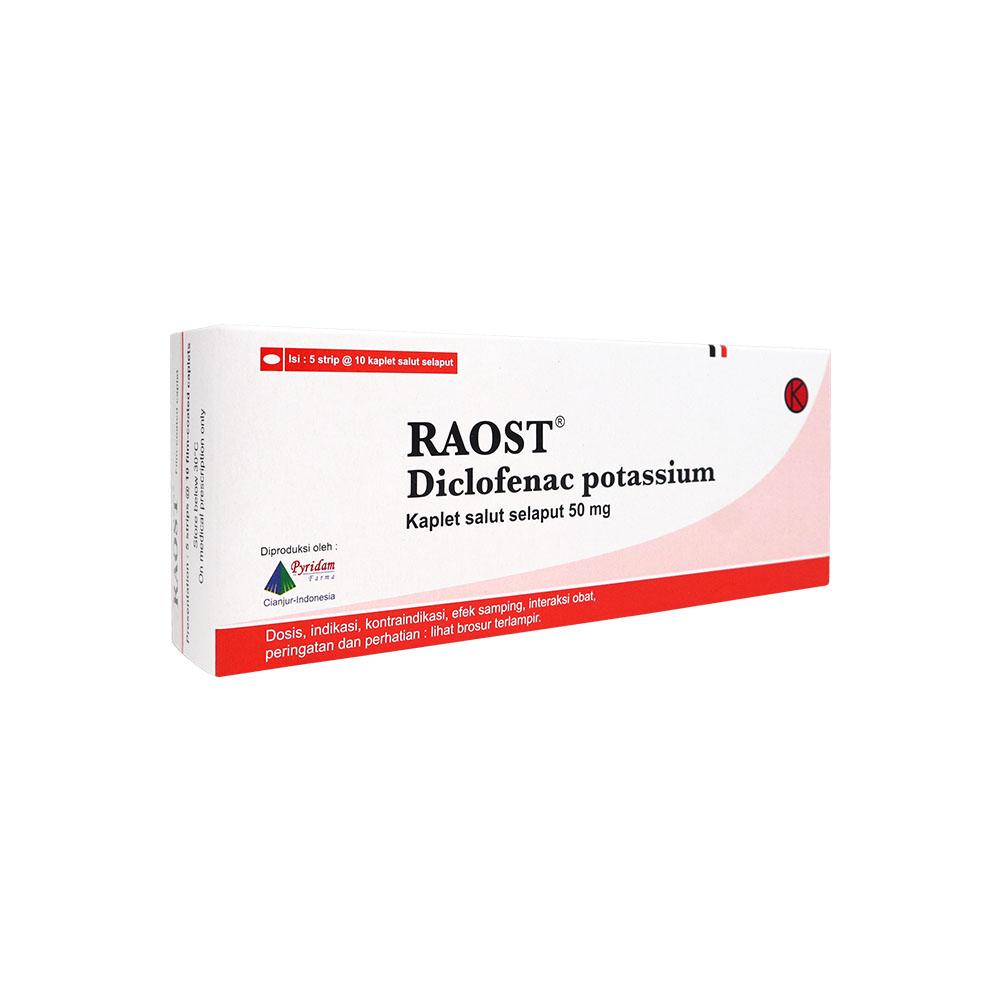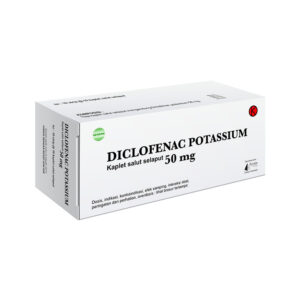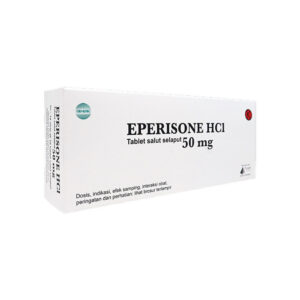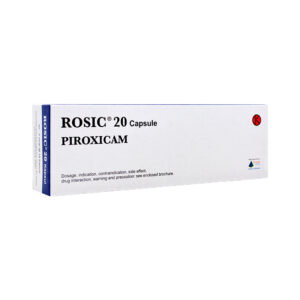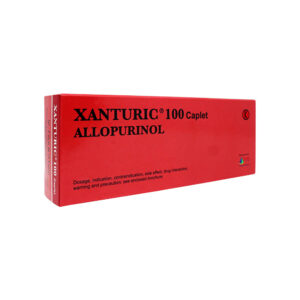Description
COMPOSITION
Each film coated caplet contains :
Potassium diclofenac …………..50 mg
PHARMACOLOGY
Potassium diclofenac is derivate from acetate benzene acid. Potassium diclofenac is a nonsteroidal anti-inflammatory agent.
Mechanism of action is by inhibition of prostaglandin biosynthesis.
Diclofenac absorbed 100% after oral administration. Diclofenac is metabolize in the liver and only 50% of the dose sistemicly
distributed throughout the body. Absorption of diclofenac is unaffected by consumption of food.
INDICATIONS
For the management of primary dysmenorrhoea
For the management of pain
Acute and chronic treatment or signs and symptoms of RA and osteoarthritis.
CONTRAINDICATIONS
Patient who hypersensitive to diclofenac.
Potassium diclofenac is contraindicated for management of pre-operation pain in artery coroner bypass surgery.
Gastric or intestinal ulcer : known hypersensitivity to the active substance or the excipients. Like other non-steroidal anti-
inflammatory drugs (NSAIDs), potassium diclofenac also contraindicated by acetylsalicylic acid or other drugs with
prostaglandin-synthetase inhibiting activity.
DOSAGE AND ADMINISTRATION
The dosage should be adjusted to the patient’s condition and start from the lowest effective dose.
Adults:
The recommended initial daily dosage is 100-150 mg. The daily dosage should generally be devided in 2-3 doses.
Dosage should not exceed 150 mg/day (for pain management and osteoarthritis), 225 mg/day (for rheumatoid arthritis).
The caplets should be swallowed whole with liquid, preferably before meals.
Children:
Potassium diclofenac film-coated caplets are not recommended for use in children.
OVERDOSAGE
In case of acute overdosge it is recommended to empty the stomach by vomiting or gastric. Teoritically, diuresis can help
because the drug is excreted through urine.
WARNINGS AND PRECAUTIONS
WARNINGS
Cardiovascular effects :
Cardiovascular thrombotic events
Clinical trials of several COX-2 selective and nonselective NSAIDs of up to three years duration have shown an increased
risk of serious cardiovascular (CV) thrombotic events, myocardial infarction, and stroke, which can be fatal. All NSAIDs,
both COX-2 selective and nonselective, may have a similar risk. Patiens with known CV disease or risk factors for CV
disease may be a greater risk. To minimize the potential risk for an adverse CV event in patients treated with an
NSAID, the lowest effective dose should be used fot the shortest duration possible. Physicians and patients should
remain alert for the development of such events, even in the absence of previous CV symptoms. Patients should be
informed about the signs and/or symptoms of serious CV events and the steps to take if they occur.
There is no consistence evidence that concurrent use of aspirin mitigates the increased risk of serious CV thrombotic
events associated with NSAID use. The concurrent use of aspirin and an NSAID does increase the risk of serious GI
events (See GI WARNINGS).
Hypertension
NSAIDs, including Potassium diclofenac, can lead to onset of new hypertension or worsening of pre-existing
hypertension, either of which may contribute to the increased incidence of CV events. Patients taking thiazides or loop
diuretics may have impaired response to these therapies when taking NSAIDs. NSAIDs, including Potassium diclofenac,
should be used with caution in patients with hypertension. Blood pressure (BP) should be monitored closely during the
initiation of NSAID treatment and throughout the course of therapy.
Congestive heart failure and edema
Fluid retention and edema have been observed in some patients taking NSAIDs. Potassium diclofenac should be used
with cautions in patients in fluid retention or heart failure.
Gastrointestinal effects-risk of ulcerations, bleeding and perforations
NSAIDs, including Potassium diclofenac, can cause serious gastrointestinal (GI) adverse events including inflammation,
bleeding, ulceration and perforation of the stomach, small intestine or large intestine, which can be fatal. These various
adverse events can occur at any time, with or without warning symptoms, in patients treated with NSAIDs. Only one in
five patients, who develop a serious upper GI adverse events on NSAID therapy, is symptomatic. Upper GI ulcers, gross
bleeding, or perforation caused by NSAIDs occur in approximately 1% of patients treated for 3-6 months, and in about
2-4% of patients treated for one year. This trends continue with longer duration of use, increasing the likelihood of
developing a serious GI events at some time during the course of therapy. However, even short-term therapy is not
without risk.
NSAIDs should be prescribed with extreme caution in those with a prior history of ulcer disease or gastrointestinal
bleeding. Patients with a prior history of peptic ulcer disease and/or gastrointestinal bleeding who use NSAIDs have a
greater than 10-fold increased risk for developing a GI bleed compaed to patients with neither of these risk factors.
Other factors that increase the risk for GI bleeding in patients treated with NSAIDs include concomitant use of oral
corticosteroids or anticoagulants, longer duration of NSAID therapy, smooking, use of alcohol, older age and poor
general health status. Most spontaneous reports of fatal GI events are in elderly or debilitated patients and therefore,
special care should be taken in treating this population.
To minimize the potential risk for an adverse GI event in patients treated with an NSAID, the lowest effective dose
should be used fo the shortest possible duration. Patients and physicians should remain alert fo signs and symptoms
of GI ulceration and bleeding during NSAID therapy and promptly initaiate additional evaluation and treatment if a
serious adverse event is suspected. For high risk patients, alternate therapies that do not involve NSAIDs should be
considered.
PRECAUTIONS
Should be carefull in used because may caused gastrointestinal (GI) bleeding and pepticum ulceration, it is
recommended to used the lowest effective dose.
As with other anti inflammations, potassium diclofenac should not recommended for pregnant women in last trimester.
Used carefully in patient with hystory of hypertension, fluid retention.
Diclofenac used in porfiria patient.
Lactation : following oral doses of 50 mg administered every 8 hours, the active substance passes into the breast milk,
but in quantities so small that no undesirable effects on the infant are to be expected. As with other drugs that
excreted in milk, potassium diclofenac is not recommended for use in nursing women.
Safety and efficacy for the use in children is not yet known.
Effects on ability to drive and use machine : patients experiencing dizziness or other central nervous disturbanceS,
including visual disturbances, should not drive or operate machinery.
ADVERSE REACTIONS
Common side effects : cramps or abdominal pain, liquid retention, diarrhea, flatulence, dizziness, rashes, pruritus.
Rare side effects : malaise, inflammation on lip dan tounge, vomiting, anaphylactic, colitis, changes in eating mood,
epistaxis, anorexia, nausea, headache, vertigo, disturbances of vision, rashes or skin eruption, oedema, urticaria,
hypertension, congestive heart failure, chest pain, thrombocytopenia, aplastic anemia, elevation of serum amino
transferase values, hypersensitivity reaction such as asthma, systemic anaphylactic, pneumonitis.
DRUG INTERACTIONS
Lithium, digoxin : potassium diclofenac may raise plasma concentrations of lithium or digoxin.
Diuretics : like other NSAIDs, potassium diclofenac may inhibit the activity of diuretics. Concomitant treatment with
potassium-sparing diuretics may be associated with increased serum potassium levels, which should therefore be
monitored.
NSAIDs : concomitant administration of systemic NSAIDs may increase the frequency of side.
Anticoagulants : there are reports of an increased risk of haemorrhage in patients receiving potassium diclofenac and
anticoagulants concomitantly. Close monitoring such patients is therefore recommended.
Anti diabetics : have been reported of both hypoglycaemic and hyperglycaemic effects necessitating changes in the
dosage of hypoglyceamic agents during treatment with potassium diclofenac.
Methotrexate : caution is called for if NSAIDs are administered less than 24 hours before or after treatment with
methotrexate, since blood concentration of methotrexate may rise and the toxicity of this substance be increased.
Cyclosporin : the effect of NSAIDs on real prostaglandins may increase the nephrotoxicity of cyclosporine.
Quinolone antibacterials : there have been reports of convulsions which may have been due to concomitant use of
quinolones and NSAIDs.
STORAGE
Keep in a cool (15˚-25˚C) and dry place.
ON MEDICAL PRESCRIPTION ONLY
PRESENTATION
Box, 5 strips @ 10 film-coated caplets



